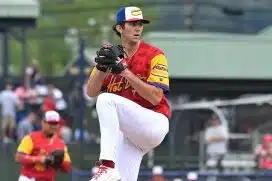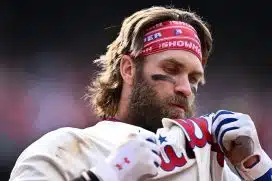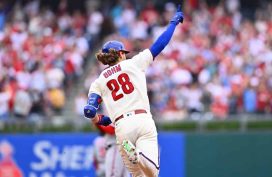By Tim Kelly, Sports Talk Philly editor
No, the Phillies taking on the contract of Giancarlo Stanton isn’t comparable to if they signed Bryce Harper or Manny Machado in free-agency after the 2018 season.
With reports from Nick Cafardo of The Boston Globe and Ken Rosenthal of FOX Sports suggesting that the Phillies have at least discussed internally the idea of pursuing Stanton, many, myself included, have pointed to his contract as one of the reasons why he isn’t a good fit for the Phillies. Those in favor of trading for Stanton, or simply desperate for the team to obtain a star, have countered by saying that any long-term contract that the team signs, such as Harper or Machado after 2018, would have similar down years at the end of their contracts.
This isn’t an argument that should resonate.
80-08 Phillies Podcast: Why Giancarlo Stanton doesn’t make sense
First of all, Harper and Machado are better players than Stanton.
Harper is two seasons removed from posting a 9.5 WAR (per FanGraphs), something that Hall of Famers Hank Aaron, Frank Robinson, Roberto Clemente and Tony Gwynn never did. Harper did it when he was 22. After a down 2016 season in which he was rumored to be injured, the 2015 National League MVP has had a bounce-back season, as he’s slashing .329/.436/.612 with 23 home runs and 72 RBIs, placing him firmly in the MVP discussion again.
Machado, on the other hand, is having a down season. Despite the fact that he has continued to display an elite glove at third base, Machado is having his least productive offensive season of his career. He does have 18 home runs and 47 RBIs, but he’s batting just .238 and has the lowest on-base percentage since his 51-game stint in 2012, which was his first big league experience. As I wrote with Harper this past offseason, if Machado continues to play like he has in 2017, he obviously wouldn’t be worth a record-setting contract after 2018. As I also said with Harper, I think Machado remains a Hall of Fame caliber player and the 88-game stint that he’s had this season will prove to be the exception, not the rule.
With all due respect to Stanton, he’s not in the same category as the aforementioned duo. He’s having a very nice season, as he’s leading the National League in home runs, but he hasn’t consistently been this player. He did have a 6-win season in 2014, but that wasn’t last week. He had a 1.7 WAR last year and has a 2.4 in 2017 (per FanGraphs). In the past two seasons combined, he has 54 home runs, largely because injuries have limited him to being able to play 193 of a possible 324 games. In 2012, he was limited to just 123 games. In 2013, he was limited to 116. What’s that saying about availability being the best ability? Because if you are going to be paying someone over $30 million per season, you would like to be sure that they are going to be playing in the range of 155 games per season.
Trending: 2017 may be it for Chase Utley and Carlos Ruiz
Here’s the other thing: I’m not normally someone in favor of giving 10-year contracts to any player because they historically have not worked out well. Machado and Harper are special because they are Hall of Fame talents, will hit free-agency when they are just 26 and are extremely unlikely to play the full-length of their contracts.
Harper will be 26, and if I had to guess, will receive a deal somewhere in the neighborhood of 10 years and $500 million. We can have a debate about whether there is any player worth $50 million per season, but the market will dictate something in that rage, pleasing capitalists. For the first six or seven seasons of that deal, you presumably would be getting Harper’s prime. The same goes for Machado, who will also be 26 when he hits free-agency.
Might the last few seasons of Harper or Machado’s contracts be ugly? It’s entirely possible, but it’s unlikely they will actually play those seasons of their contracts. Like Alex Rodriguez did in 2000, Harper and Machado are likely to sign record-setting 10-year deals at age 26. After the seventh year of Rodriguez’s contract, when he was 32 and fresh off of winning his third MVP, Rodriguez opted out of the last three years of his deal and eventually signed a new 10-year/$275 contract with the Yankees. Harper and Machado are likely to follow a similar route, meaning whatever team signs the two after 2018 will likely only be locked into paying for the primes of two future Hall of Famers. The two will likely opt-out at some point at the back-end of their deals, at which point whatever team they are playing with would be forced to consider whether they want to give a player on the wrong side of 30 a 10-year deal.
Even if the two play the full length of the deal, both seem likely to age well because they are well-rounded players and not reliant on one specific part of their game. If not, there’s worse things than having a Hall of Fame caliber player from age 26-35.
While potential opt-outs actually make Harper and Machado more attractive to perspective suitors, a potential opt-out from Stanton makes him less attractive. Stanton, who is a few years older than Harper and Machado, can opt-out after 2020, his age-30 season. If he’s playing at any level similar to what he is in 2017, he’s likely to exercise this option. This will be after Harper and Machado both reset the MLB contract record books and in the same offseason that Mike Trout could potentially be a free-agent. So the Phillies, who may just be starting to become a contender at this time, would be forced to either lose potentially their best player or possibly give a 10-year deal to a player that’s over 30 years old.
Popular: Billy Wagner says he would vote for Chase Utley and Jimmy Rollins for Hall of Fame
If Stanton doesn’t opt-out, it’s likely because he’s struggled to stay healthy and/or underperformed. It seems fairly realistic to think that Stanton won’t have better health as he gets older. When you couple a history of injuries and the fact that he’s so reliant on being able to generate other-worldy power, the idea of having to pay Stanton $118 million between ages 34 and 37 is pretty scary.
None of this takes into account that signing Harper and Machado would only require draft compensation, while trading for Stanton, even if the Phillies assumed a large portion of his contract, would involve parting with some top prospects.
Do the Phillies need a superstar talent? Absolutely. So do about 25 other teams. But paying someone who has an injury history, doesn’t consistently play at a superstar level and may not age well doesn’t seem like the recipe for landing the Phillies on a parade float. It seems like the recipe for throwing away a few seasons next decade. It’s very possible that the Phillies won’t land Harper or Machado after 2018. That still wouldn’t make trading for Stanton the right move for the Phillies.
Frankly, this debate may prove to be rather futile. Rosenthal’s report specifically noted that while the Phillies have discussed the idea of making a move for Stanton internally, they haven’t made their interest known to the Marlins. The same report suggested that they have made their interest in Christian Yelich known to the Marlins, leading you to think that if they were serious about making a run at Stanton, they would have done the same. (For what it’s worth, multiple outlets noted yesterday that the Marlins, in the midst of an ownership change that only Jeffrey Loria could lead, aren’t prepared to listen on Stanton, Yelich or Marcell Ozuna at this time. Even if they were willing to move Stanton and the Phillies were seriously interested, Stanton has a full no-trade clause that he would have to waive for any trade to go through.)
These type of Twitter-shattering discussions take place within organizations all the time. If general manager Matt Klentak and the Phillies are smart, they’ve come to the conclusion that attempting to land Harper or Machado after 2018 makes quite a bit of sense. Despite his tremendous talent, the same can’t be said for Stanton.







